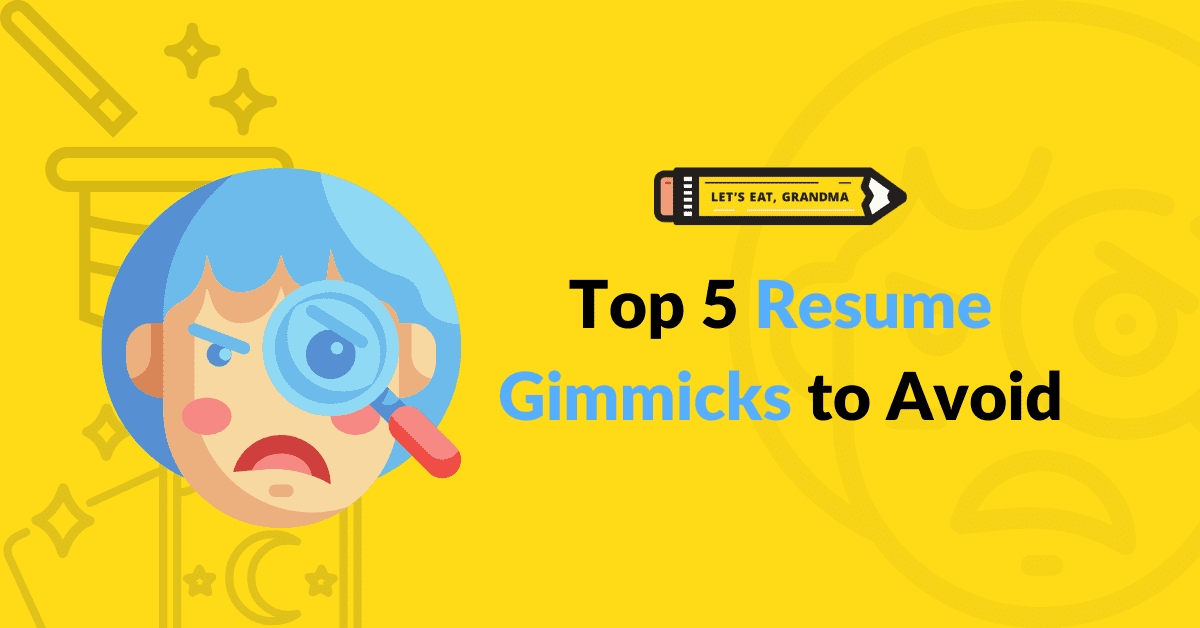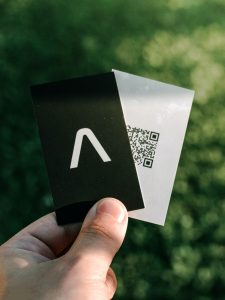Top 5 Resume Hacks to Avoid (And What to Do Instead)

You’ve probably heard of them before: Resume “hacks” like squeezing in a bunch of keywords in tiny, white text have been passed around for a long time. Here are a few of our favorite (to avoid).
Updated December 2022.
By: Jennifer Meehan | Contributor for Let’s Eat, Grandma
Prefer audio? Follow along with our podcast episode on the same topic:
Job seekers are so concerned with “standing out” in the hiring process that the desire for quick resume hacks often overtakes what should be the first priority: good content.
Of course you want to stand out, but there is a right and wrong way to go about it. Don’t fall for the gimmicks. Read on for what to do instead.
Tired of not landing interviews?
Get our free 3-step guide to writing better resume bullet points, featuring 70 ideas for metrics you can use!
Resume ‘Hack’ to Avoid #1: Photo
The Appeal: Maybe you figure your LinkedIn headshot came out so well, why not put it on your resume too? You might think employers can get a good idea of what you’re like just by looking at that great smile!
Many resume templates have room for a photo, but including one is a terrible idea. It isn’t exactly illegal, but it’s certainly frowned upon. And some companies have policies specifically against this practice, which would get your resume tossed immediately.
The most important and obvious reason is that a photo can lead to discrimination in terms of gender, race, age, ability, or appearance. Another is that the headshot you’re so proud of could really mess with an Applicant Tracking System. An ATS is designed to parse only text, so photos would just confuse things and lead to mistakes in how your info is presented. Don’t risk it!
What to do instead: Use that space that would have been taken up by a picture to add relevant, accomplishment-focused content to your Summary of Qualifications or Professional Experience bullet points. Or simply leave some necessary white space, especially if you’re handing out printed copies of your resume or emailing a recruiter directly.
Resume ‘Hack’ to Avoid #2: QR Code
The Appeal: It looks cool, it might help you stand out from other job seekers, and it shows off your tech skills. For older applicants especially, showing you know how to use a QR code might improve your chances of getting an interview. But these considerations apply if – and only if – you’re handing out a physical resume at a career fair.

A QR code is only ever OK if you’re physically handing it to a hiring manager — and even then, you might as well just print out a copy of your resume. Photo by Apollo Photography on Unsplash
You see these patterns of black squares everywhere. In these pandemic years they’ve been particularly prevalent in restaurants, where you scan them to see a menu. People use them to link to a portfolio, website, or LinkedIn profile so they can supplement their resume. But unless you’re applying for a tech-savvy job, where it might be a good idea to include one, a QR code has no business on a resume.
The last thing you want to do is annoy the manager who is reading your resume. If you depend on the code to fill in important information on a resume, the manager may not feel like taking the time to scan it when she has hundreds of resumes on her desk. The manager might also be trying to read your resume on a smartphone and have no way to scan the code while she’s reading!
What to do instead: Save the space and use hyperlinks to other relevant information about you, like your LinkedIn profile or work samples.
Resume ‘Hack’ to Avoid #3: Skill Bars
The Appeal: Organizing your skills into levels of proficiency may seem like a good way to hack your resume to get recruiters more interested. Your skills are in one tidy box, and the reader will see right away how good you are at something like Photoshop.
Skill bars or rating scales are one of the worst things you could include on your resume. For one thing they can be visually unappealing and distracting, but more important, they don’t make sense. Basically, you’re comparing apples to oranges when you rate yourself on skills of vastly different difficulty, like Excel and Graphic Design.
Also, you’re rating yourself! There is no objective evaluation of general work skills, making your scales pretty meaningless. Recruiters hate skill ratings, so they might cause your otherwise impressive resume to get tossed. But even worse, Applicant Tracking Systems don’t recognize them, so they might be converted into gibberish.
What to do instead: Include your technical job skills under a Relevant Skills heading in your resume and mention your “soft” skills like “excellent communicator” in your cover letter and Professional Experience section. If you explain your past experience correctly there is no need for a skill bar.
Resume ‘Hack’ to Avoid #4: Graphics
The Appeal: Everyone wants to stand out in a crowded job market. The traditional resume, with its horizontal, black and white format can seem boring. If you’re in a creative field, it might make sense to hack your resume by including infographics and visual elements. However…

There’s no need to include graphics, charts, graphs, or skill bars on your resume. Photo by Lukas Blazek on Unsplash
Not only are graphics bad for the ATS, they are also distracting for a recruiter. Unless you’re applying for a job in a creative field, don’t include pie charts, graphs, tables, word bubbles or any other graphic that will interrupt the flow of your resume. Even in the case of creatives, 70% of recruiters say they prefer traditional resumes. For all but explicitly creative positions, recruiters will care much more that you used a font that’s easy to read and a clear format than about how fancy your design is.
What to do instead: Write and submit a traditional resume with work experience and skills. You can then add a hyperlink to the more creative one that demonstrates your skills. Your basic resume will get through the ATS and it will be easier to read for the first human who looks at it, someone who isn’t necessarily in a creative role. That person usually only wants to scan it for relevance to the job opening, not have to hunt for your qualifications. A no-frills resume is more likely to be sent up the chain to the actual decision-makers.
Resume ‘Hack’ to Avoid #5: White Fonting (Invisible Keywords)
The Appeal: The more keywords the better, the thinking goes. Panic and misinformation about Applicant Tracking Systems might have told you that an ATS is a gatekeeper that will reject your resume before a human sees it if you don’t have enough keywords. You might then think it’s time to use a resume hack like tiny white font to squeeze in as many keywords as possible.
Here’s the thing: it’s well known that an ATS will scan your resume text for keywords that a recruiter searches for. Including specific keywords from the job description on your resume and cover letter is actually a good way to get your application more visible in the system, as long as you don’t overdo it.
But you should never try to trick an ATS with invisible keywords pointing to skills you don’t possess. “White fonting” is the practice of typing keywords several times in a resume, then changing the font to white so a human can’t read it. This “technique” will invariably fail and get your resume tossed.
The tracking systems will parse your resume into a plain text profile for the recruiter, so all those extra words will pop up and look ridiculous. And, by the way, they will also show that you were trying to cheat. There are some great examples on this blog.
What to do instead: Use keyword optimization, not keyword stuffing. Remember, a human is actually going to read your material, so make it meaningful and readable. This means seamlessly working a few keywords into your Professional Experience, Skills, and Summary sections. You should also use the same language and terms used in the job description. For example, if the description uses the title Marketing Assistant, then be sure to use that term at the top of your resume instead of Marketing Coordinator or Marketing Associate.
Next time you see a “brilliant” idea for getting your resume noticed, remember it’s the content that counts. A clean, readable document tailored to the job you’re seeking will win out every time.
Ready for more job search help?
Sign up for a free Senior Writer Resume Critique to see what's holding you back from landing interviews. One of our top professional resume writers will give you personalized feedback on the top 3 items you can improve based on our expert practices!
Better Resume.
Satisfying Career.
Happier You.
